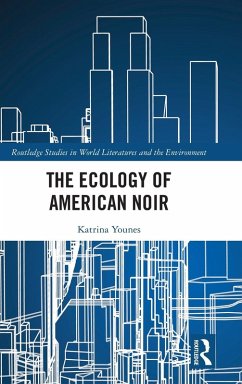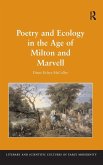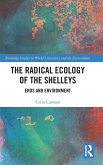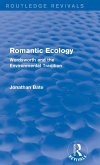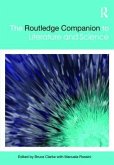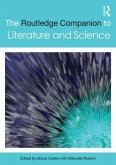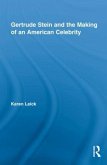Katrina Younes
The Ecology of American Noir
Katrina Younes
The Ecology of American Noir
- Gebundenes Buch
- Merkliste
- Auf die Merkliste
- Bewerten Bewerten
- Teilen
- Produkt teilen
- Produkterinnerung
- Produkterinnerung
This volume investigates the relationship between the conventions of noir fiction and film and its sub-types in relation to environmental crises.
Andere Kunden interessierten sich auch für
![Poetry and Ecology in the Age of Milton and Marvell Poetry and Ecology in the Age of Milton and Marvell]() Diane Kelsey McColleyPoetry and Ecology in the Age of Milton and Marvell185,99 €
Diane Kelsey McColleyPoetry and Ecology in the Age of Milton and Marvell185,99 €![The Radical Ecology of the Shelleys The Radical Ecology of the Shelleys]() Colin CarmanThe Radical Ecology of the Shelleys176,99 €
Colin CarmanThe Radical Ecology of the Shelleys176,99 €![Romantic Ecology (Routledge Revivals) Romantic Ecology (Routledge Revivals)]() Jonathan BateRomantic Ecology (Routledge Revivals)195,99 €
Jonathan BateRomantic Ecology (Routledge Revivals)195,99 €![The Routledge Companion to Literature and Science The Routledge Companion to Literature and Science]() The Routledge Companion to Literature and Science272,99 €
The Routledge Companion to Literature and Science272,99 €![The Routledge Companion to Literature and Science The Routledge Companion to Literature and Science]() The Routledge Companion to Literature and Science49,99 €
The Routledge Companion to Literature and Science49,99 €![The Scandinavian Invasion The Scandinavian Invasion]() The Scandinavian Invasion66,95 €
The Scandinavian Invasion66,95 €![Gertrude Stein and the Making of an American Celebrity Gertrude Stein and the Making of an American Celebrity]() Karen LeickGertrude Stein and the Making of an American Celebrity117,99 €
Karen LeickGertrude Stein and the Making of an American Celebrity117,99 €-
-
-
This volume investigates the relationship between the conventions of noir fiction and film and its sub-types in relation to environmental crises.
Produktdetails
- Produktdetails
- Verlag: Routledge
- Seitenzahl: 142
- Erscheinungstermin: 6. April 2025
- Englisch
- Abmessung: 235mm x 157mm x 12mm
- Gewicht: 367g
- ISBN-13: 9781032931555
- ISBN-10: 1032931558
- Artikelnr.: 72011455
- Herstellerkennzeichnung
- Libri GmbH
- Europaallee 1
- 36244 Bad Hersfeld
- gpsr@libri.de
- Verlag: Routledge
- Seitenzahl: 142
- Erscheinungstermin: 6. April 2025
- Englisch
- Abmessung: 235mm x 157mm x 12mm
- Gewicht: 367g
- ISBN-13: 9781032931555
- ISBN-10: 1032931558
- Artikelnr.: 72011455
- Herstellerkennzeichnung
- Libri GmbH
- Europaallee 1
- 36244 Bad Hersfeld
- gpsr@libri.de
Katrina Younes is an Assistant Professor (Limited Duties) at Western University's Department of Gender, Sexuality and Women's Studies.
Introduction to The Ecology of American Noir
0.1 What is The Ecology of American Noir?
0.2 Defining American Noir
0.3 Defining Eco-Noir
0.4 Detailed Overview of the Chapters
Chapter 1: The Hardboiled Eco-Awareness of Dashiell Hammett and Raymond
Chandler
1.1 Introduction: The Fragmented Ecologies of Dashiell Hammett and Raymond
Chandler
1.2 Hammett and Chandler's Fragmented Scales
1.3 Red Harvest (1929)
1.4 From Personville to Poisonville
1.5 The Big Sleep (1939)
1.6 Conclusion
Chapter 2: Exploitation and Extraction in Chinatown and The Two Jakes
2.1 From Noir to Neo-Noir
2.2 Chinatown and The Two Jakes
2.3 Resource Extraction in the Films
2.4 Neo-Noir Perception
2.5 Incest
2.6 Race
2.7 Looking Ahead: What The Two Jakes Tells us About The Future
2.8 Conclusion
Chapter 3: Rhizomatic Eco-Noir Visions of New York 2140 and Hummingbird
Salamander
3.1"What is Happening?" and "What Happened?"
3.2 Methodology
3.3 The New Nordic Noir
3.4 New York 2140
3.5 The Collective PI and the Rhizomatic Map of New York City
3.6 Regenerating Crime and Violence
3.7 The Scene of the Seen Victim
3.8 Hummingbird Salamander: The Rhizome and the "Weird"
3.9 The Hardboiled and Weird Female Green PI
3.10 The Eco-Crime Scene and Olfactory Sensations
3.11 Conclusion
Chapter 4: Afterword
4.1 Introduction: Eco-Noir Han
4.2 Introduction to The Silent Sea and Eco-Noir Han
4.3 Collective Detectiveships, Lunar Water, and Luna
4.4 Conclusion
0.1 What is The Ecology of American Noir?
0.2 Defining American Noir
0.3 Defining Eco-Noir
0.4 Detailed Overview of the Chapters
Chapter 1: The Hardboiled Eco-Awareness of Dashiell Hammett and Raymond
Chandler
1.1 Introduction: The Fragmented Ecologies of Dashiell Hammett and Raymond
Chandler
1.2 Hammett and Chandler's Fragmented Scales
1.3 Red Harvest (1929)
1.4 From Personville to Poisonville
1.5 The Big Sleep (1939)
1.6 Conclusion
Chapter 2: Exploitation and Extraction in Chinatown and The Two Jakes
2.1 From Noir to Neo-Noir
2.2 Chinatown and The Two Jakes
2.3 Resource Extraction in the Films
2.4 Neo-Noir Perception
2.5 Incest
2.6 Race
2.7 Looking Ahead: What The Two Jakes Tells us About The Future
2.8 Conclusion
Chapter 3: Rhizomatic Eco-Noir Visions of New York 2140 and Hummingbird
Salamander
3.1"What is Happening?" and "What Happened?"
3.2 Methodology
3.3 The New Nordic Noir
3.4 New York 2140
3.5 The Collective PI and the Rhizomatic Map of New York City
3.6 Regenerating Crime and Violence
3.7 The Scene of the Seen Victim
3.8 Hummingbird Salamander: The Rhizome and the "Weird"
3.9 The Hardboiled and Weird Female Green PI
3.10 The Eco-Crime Scene and Olfactory Sensations
3.11 Conclusion
Chapter 4: Afterword
4.1 Introduction: Eco-Noir Han
4.2 Introduction to The Silent Sea and Eco-Noir Han
4.3 Collective Detectiveships, Lunar Water, and Luna
4.4 Conclusion
Introduction to The Ecology of American Noir
0.1 What is The Ecology of American Noir?
0.2 Defining American Noir
0.3 Defining Eco-Noir
0.4 Detailed Overview of the Chapters
Chapter 1: The Hardboiled Eco-Awareness of Dashiell Hammett and Raymond
Chandler
1.1 Introduction: The Fragmented Ecologies of Dashiell Hammett and Raymond
Chandler
1.2 Hammett and Chandler's Fragmented Scales
1.3 Red Harvest (1929)
1.4 From Personville to Poisonville
1.5 The Big Sleep (1939)
1.6 Conclusion
Chapter 2: Exploitation and Extraction in Chinatown and The Two Jakes
2.1 From Noir to Neo-Noir
2.2 Chinatown and The Two Jakes
2.3 Resource Extraction in the Films
2.4 Neo-Noir Perception
2.5 Incest
2.6 Race
2.7 Looking Ahead: What The Two Jakes Tells us About The Future
2.8 Conclusion
Chapter 3: Rhizomatic Eco-Noir Visions of New York 2140 and Hummingbird
Salamander
3.1"What is Happening?" and "What Happened?"
3.2 Methodology
3.3 The New Nordic Noir
3.4 New York 2140
3.5 The Collective PI and the Rhizomatic Map of New York City
3.6 Regenerating Crime and Violence
3.7 The Scene of the Seen Victim
3.8 Hummingbird Salamander: The Rhizome and the "Weird"
3.9 The Hardboiled and Weird Female Green PI
3.10 The Eco-Crime Scene and Olfactory Sensations
3.11 Conclusion
Chapter 4: Afterword
4.1 Introduction: Eco-Noir Han
4.2 Introduction to The Silent Sea and Eco-Noir Han
4.3 Collective Detectiveships, Lunar Water, and Luna
4.4 Conclusion
0.1 What is The Ecology of American Noir?
0.2 Defining American Noir
0.3 Defining Eco-Noir
0.4 Detailed Overview of the Chapters
Chapter 1: The Hardboiled Eco-Awareness of Dashiell Hammett and Raymond
Chandler
1.1 Introduction: The Fragmented Ecologies of Dashiell Hammett and Raymond
Chandler
1.2 Hammett and Chandler's Fragmented Scales
1.3 Red Harvest (1929)
1.4 From Personville to Poisonville
1.5 The Big Sleep (1939)
1.6 Conclusion
Chapter 2: Exploitation and Extraction in Chinatown and The Two Jakes
2.1 From Noir to Neo-Noir
2.2 Chinatown and The Two Jakes
2.3 Resource Extraction in the Films
2.4 Neo-Noir Perception
2.5 Incest
2.6 Race
2.7 Looking Ahead: What The Two Jakes Tells us About The Future
2.8 Conclusion
Chapter 3: Rhizomatic Eco-Noir Visions of New York 2140 and Hummingbird
Salamander
3.1"What is Happening?" and "What Happened?"
3.2 Methodology
3.3 The New Nordic Noir
3.4 New York 2140
3.5 The Collective PI and the Rhizomatic Map of New York City
3.6 Regenerating Crime and Violence
3.7 The Scene of the Seen Victim
3.8 Hummingbird Salamander: The Rhizome and the "Weird"
3.9 The Hardboiled and Weird Female Green PI
3.10 The Eco-Crime Scene and Olfactory Sensations
3.11 Conclusion
Chapter 4: Afterword
4.1 Introduction: Eco-Noir Han
4.2 Introduction to The Silent Sea and Eco-Noir Han
4.3 Collective Detectiveships, Lunar Water, and Luna
4.4 Conclusion

